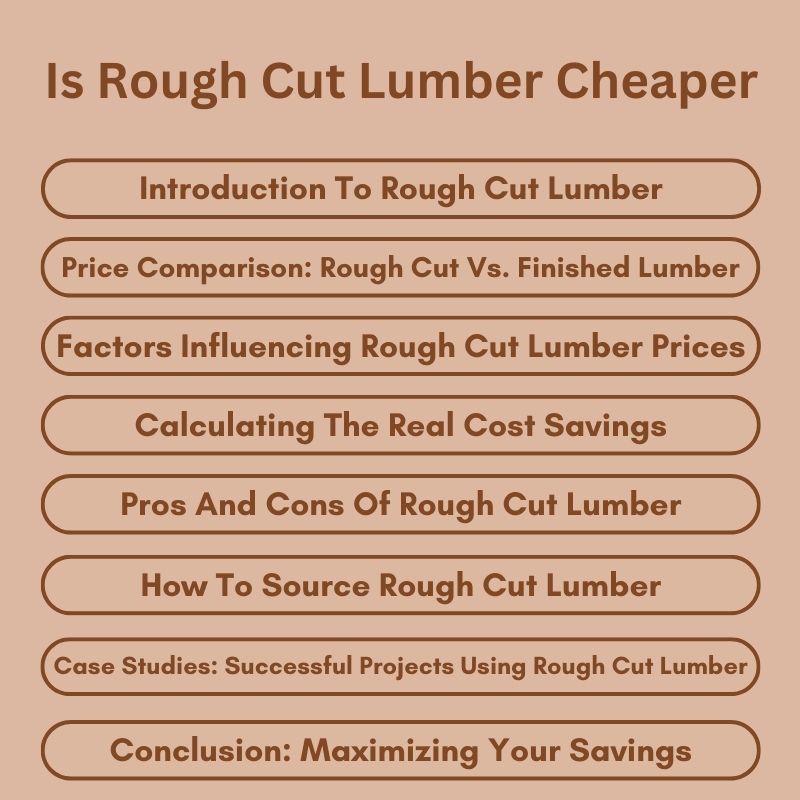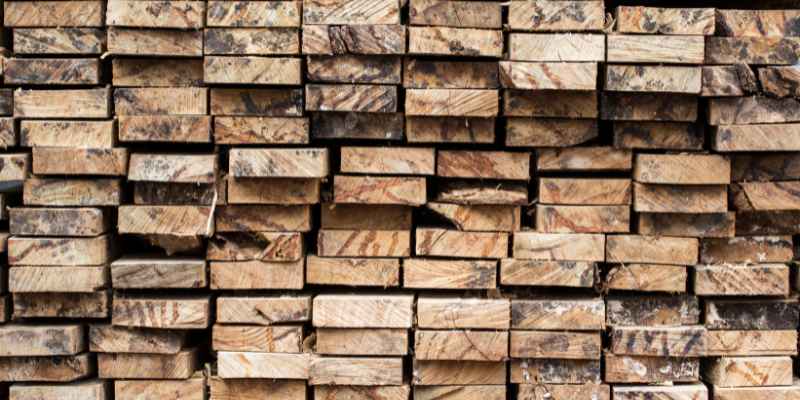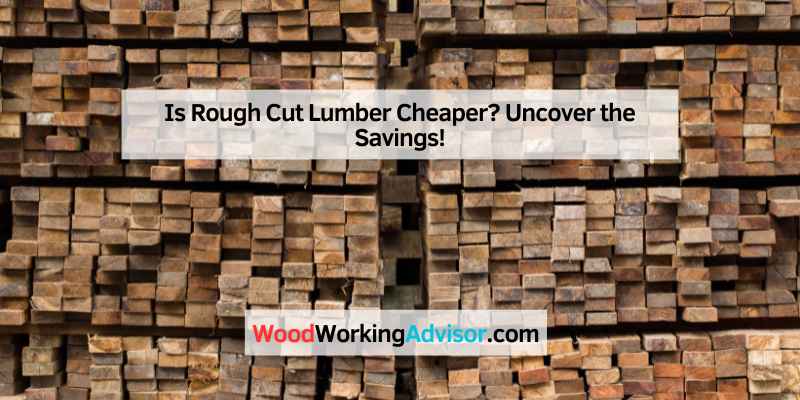Rough cut lumber is generally cheaper than finished lumber. Its lower price reflects less processing and fewer manufacturing steps.
Rough cut lumber offers an economical alternative for various woodworking projects. This type of lumber is harvested directly from logs and requires minimal processing. As a result, it retains a more natural appearance and character. Many DIY enthusiasts and professional builders appreciate its affordability and versatility.
Using rough cut lumber allows for greater customization, as it can be shaped and finished according to specific needs. This lumber is ideal for structural applications, furniture making, and rustic designs. Understanding the benefits and cost-effectiveness of rough cut lumber can help you make informed decisions for your next project. Explore your options and consider rough cut lumber for your woodworking needs.
Introduction To Rough Cut Lumber
Rough cut lumber is a popular choice for many builders and DIY enthusiasts. It offers a unique aesthetic and can save money on projects. Understanding what it is and its benefits can help you make informed decisions.
What Is Rough Cut Lumber?
Rough cut lumber refers to wood that has been cut but not finished. It retains a natural look, showcasing its unique grain and texture. Here are some key features:
- Unfinished Surface: The wood has not been smoothed or planed.
- Thickness Variations: The dimensions can vary, adding character.
- Natural Edges: Some pieces may still have bark or irregular edges.
Benefits Of Using Rough Cut Lumber
Choosing rough cut lumber offers several advantages:
- Cost-Effective: It is usually cheaper than finished lumber.
- Unique Appearance: Each piece has its own character.
- Environmentally Friendly: Often sourced from local mills.
- Versatile: Suitable for various projects, from furniture to framing.
Here’s a quick comparison of rough cut vs. finished lumber:
| Feature | Rough Cut Lumber | Finished Lumber |
|---|---|---|
| Cost | Lower | Higher |
| Surface Finish | Unfinished | Smooth and polished |
| Customization | More options for DIY | Limited to stock sizes |

Price Comparison: Rough Cut Vs. Finished Lumber
Understanding the price differences between rough cut and finished lumber is crucial. This helps you make informed decisions for your projects. Below, we explore initial costs and long-term value.
Initial Cost Differences
The initial cost of rough cut lumber is generally lower than that of finished lumber. This price difference arises from several factors:
- Processing: Rough cut lumber requires less processing.
- Labor: Finished lumber involves more labor and machinery.
- Materials: Rough cut often uses less expensive wood types.
| Type of Lumber | Average Cost per Board Foot |
|---|---|
| Rough Cut Lumber | $1.50 – $3.00 |
| Finished Lumber | $3.00 – $6.00 |
Long-term Value
While rough cut lumber is cheaper initially, consider its long-term value. Here are key points:
- Durability: Rough cut lumber may last longer if properly treated.
- Customization: It offers more flexibility for custom projects.
- Maintenance: Finished lumber often requires less maintenance.
Evaluate your project needs. The right choice depends on budget and requirements.
Factors Influencing Rough Cut Lumber Prices
Understanding the price of rough cut lumber involves several key factors. These elements can cause prices to fluctuate widely. Let’s explore these factors in detail.
Wood Species And Availability
The type of wood significantly affects lumber prices. Some species are more common than others. Here are a few popular wood species:
- Pine: Affordable and widely available.
- Oak: Durable but costs more.
- Maple: Rare and often expensive.
Availability also plays a role. If a species is scarce, prices rise. Conversely, abundant species tend to be cheaper.
Market Demand And Supply
Market demand impacts lumber prices. High demand pushes prices up. Low demand can lead to reduced costs.
Key factors affecting demand include:
- Construction trends
- Renovation projects
- Seasonal changes
Supply also matters. If mills produce more lumber, prices may drop. Less production usually leads to higher prices.
Location And Transportation Costs
Location affects lumber prices. Regions with sawmills offer lower costs. Transportation adds extra fees.
Consider these factors:
| Factor | Impact on Price |
|---|---|
| Distance from Sawmills | Higher costs for longer distances |
| Local Regulations | Compliance costs can increase prices |
| Transportation Mode | Shipping by truck is more expensive |
Understanding these factors helps buyers make informed choices. Prices for rough cut lumber vary greatly. Being aware of these influences can guide purchasing decisions.
Calculating The Real Cost Savings
Understanding the true savings of rough cut lumber is crucial. It offers potential budget benefits for both DIY enthusiasts and professionals. Let’s dive deeper into how this can impact your projects.
DIY Projects
Using rough cut lumber can significantly cut costs in DIY projects. Here are some benefits:
- Lower Price: Rough cut lumber is cheaper than finished wood.
- Unique Style: It adds a rustic charm to your creations.
- Easy to Work With: It can be customized easily for various projects.
Consider the following table for cost comparison:
| Type of Lumber | Average Cost per Board Foot | Common Uses |
|---|---|---|
| Rough Cut Lumber | $2.00 | Furniture, Shelving |
| Finished Lumber | $4.00 | Framing, Cabinets |
Rough cut lumber can save you money on projects like:
- Wooden benches
- Garden beds
- Bookshelves
Professional Construction Uses
Professionals can also benefit from using rough cut lumber. Here are some advantages:
- Cost Efficiency: Saves money on large projects.
- Material Availability: Often easier to find than finished products.
- Flexibility: Works well for custom builds.
Consider how rough cut lumber can impact project budgets:
| Project Type | Rough Cut Cost | Finished Lumber Cost | Potential Savings |
|---|---|---|---|
| Decking | $1,500 | $2,500 | $1,000 |
| Framing | $3,000 | $4,500 | $1,500 |
Rough cut lumber can be ideal for:
- Residential construction
- Commercial buildings
- Custom renovations
Pros And Cons Of Rough Cut Lumber
Rough cut lumber is gaining popularity for various projects. Understanding the pros and cons helps in making an informed choice. This section explores the advantages and challenges associated with rough cut lumber.
Advantages Of Rough Cut Lumber
- Cost-Effective: Rough cut lumber is often cheaper than finished lumber.
- Unique Aesthetics: It offers a rustic and natural look.
- Customization: Easier to tailor for specific projects.
- Sustainability: Often sourced from local mills, reducing transport emissions.
- Durability: Can be more resilient than processed wood.
Challenges And Considerations
- Inconsistent Dimensions: Rough cut lumber may not be uniform.
- More Preparation: Requires additional sanding and finishing.
- Moisture Content: Higher moisture levels can lead to warping.
- Limited Availability: Not all suppliers carry rough cut options.
- Pest Issues: Increased risk of pests if not treated properly.
| Aspect | Rough Cut Lumber | Finished Lumber |
|---|---|---|
| Cost | Lower | Higher |
| Aesthetics | Rustic | Sleek |
| Preparation | More Required | Minimal |
| Durability | High | Variable |
How To Source Rough Cut Lumber
Sourcing rough cut lumber can be simple and cost-effective. Various options exist for finding quality lumber. Explore local sawmills, online marketplaces, and tips for selecting the best materials.
Local Sawmills And Suppliers
Local sawmills are excellent places to find rough cut lumber. They often sell directly to customers, offering lower prices. Here are some benefits of sourcing from local sawmills:
- Freshly cut lumber: You’ll find wood that is freshly milled.
- Variety: Many types of wood are available.
- Support local economy: Buy from your community.
Visit local suppliers to compare prices and quality. Ask for recommendations from friends or contractors.
Online Marketplaces
Online marketplaces offer another way to find rough cut lumber. Websites like Craigslist, eBay, and Facebook Marketplace have listings. Consider these points:
- Convenience: Shop from home at any time.
- Wider selection: Access lumber from various locations.
- Price comparisons: Easily compare prices across listings.
Check seller ratings and reviews before making a purchase. Look for sellers who provide clear photos and descriptions.
Tips For Selecting Quality Lumber
Selecting high-quality rough cut lumber is crucial. Follow these tips to ensure you choose the best materials:
- Inspect for defects: Look for cracks, knots, and warping.
- Check moisture content: Use a moisture meter if possible.
- Ask about the source: Know where the wood comes from.
- Consider the species: Different woods have unique properties.
By following these tips, you can find durable and reliable lumber for your projects.
Case Studies: Successful Projects Using Rough Cut Lumber
Rough cut lumber is gaining popularity in various projects. Many builders and artisans choose this material for its unique look and cost-effectiveness. Here are some successful case studies that highlight its versatility.
Residential Construction
Rough cut lumber is a favorite in home building. It offers a rustic charm and solid structure. Here are some key benefits:
- Affordability: Lower material costs compared to finished lumber.
- Unique Aesthetic: Each piece has its own character.
- Environmentally Friendly: Less processing means a lower carbon footprint.
For example, a family in Oregon built their dream home using rough cut cedar. The result was stunning. They saved 30% on lumber costs.
Furniture Making
Many artisans use rough cut lumber for furniture. This wood creates beautiful, one-of-a-kind pieces. Here’s what makes it special:
- Durability: Rough cut lumber is often stronger.
- Customizable: Easier to shape and finish.
- Artistic Value: Each grain tells a story.
A local craftsman in Texas made a dining table from rough oak. The table became a centerpiece in many homes. Clients loved its charm and strong build.
Outdoor Structures
Rough cut lumber is ideal for outdoor projects. It withstands weather and adds natural beauty. Some examples include:
| Project Type | Materials Used | Benefits |
|---|---|---|
| Decks | Pine, Cedar | Long-lasting, slip-resistant |
| Gazebos | Redwood, Spruce | Sturdy, visually appealing |
| Fences | Poplar, Hemlock | Cost-effective, unique design |
A couple in Colorado built a gazebo using rough cut spruce. It blended beautifully with their garden. Neighbors admired its unique look and durability.
Conclusion: Maximizing Your Savings
Finding the best deals on rough cut lumber can save you money. This section will help you discover effective strategies to maximize your savings. Understanding the market and using smart buying practices is key.
Best Practices For Buying Rough Cut Lumber
To secure the best prices on rough cut lumber, follow these tips:
- Shop Local: Buy from local mills or suppliers.
- Buy in Bulk: Purchasing larger quantities often reduces costs.
- Negotiate: Don’t hesitate to ask for discounts.
- Inspect Quality: Check each piece for defects before buying.
- Seasonal Sales: Look for sales during off-peak seasons.
Consider these factors:
| Factor | Impact on Price |
|---|---|
| Location | Shipping costs may increase prices. |
| Wood Type | Rare woods cost more than common types. |
| Supplier | Prices vary by supplier reputation. |
Future Trends In Lumber Pricing
Understanding future trends can help you plan purchases better. Here are some trends to watch:
- Demand Fluctuations: Increased demand can raise prices.
- Environmental Regulations: Stricter laws may affect availability.
- Technology Advances: New milling techniques could lower costs.
- Sustainable Practices: Eco-friendly lumber may gain popularity.
Stay informed about these trends to make wise buying decisions. This knowledge can lead to more savings in the long run.

Frequently Asked Questions
Is Rough Cut Lumber Less Expensive Than Finished Wood?
Yes, rough cut lumber is generally cheaper than finished wood. This is because it requires less processing and fewer resources. However, the price may vary based on the type of wood and local market conditions. Always compare prices before making a purchase.
What Are The Benefits Of Using Rough Cut Lumber?
Rough cut lumber offers several advantages, including cost savings and unique character. It can be more sustainable, as it often comes from local sources. Additionally, it provides a rustic aesthetic that many homeowners and builders appreciate. It’s a versatile option for various projects.
How Is Rough Cut Lumber Different From Finished Lumber?
Rough cut lumber is milled but not sanded or finished. This means it retains a more natural appearance, showcasing the wood’s grain and texture. Finished lumber, on the other hand, is smoothed and treated for a polished look. The choice depends on your project needs and design preferences.
Where Can I Buy Rough Cut Lumber?
You can purchase rough cut lumber at local sawmills, lumber yards, or specialty wood suppliers. Many online retailers also offer various types of rough cut wood. Be sure to check local listings to find the best deals and options available in your area.
Conclusion
Rough cut lumber often offers a more affordable option for various projects. Its cost-effectiveness can be appealing for DIY enthusiasts and builders alike. However, consider potential finishing and installation expenses. Weigh your options carefully to ensure you make the best choice for your budget and project needs.

